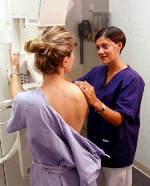 The benefits and risks of mammogram screenings have been debated for years, but according to the United States Preventative Services Task Force (USPSTF), women between the ages of 40 and 49 should not get routine mammograms.
The benefits and risks of mammogram screenings have been debated for years, but according to the United States Preventative Services Task Force (USPSTF), women between the ages of 40 and 49 should not get routine mammograms.
Their recommendation caused a lot of controversy in the medical community. Everybody weighed in on the issue. The American Medical Association, the College of Radiology, and the American Cancer Society, amongst others, issued their own guidelines. In effect, these respected organizations recommended mammography screening for all women, including those who are only in their 40s.
Many medical organizations, like those mentioned above, believe that mammograms save lives—although it’s true that this is more pronounced in those who are over the age of 50.
What accounts for this difference of opinion? It could be that the USPSTF is worried about women being exposed to radiation. However, a mammogram only exposes a patient to a small amount of radiation—less than the radiation that is given off during a standard chest x-ray.
They’re also worried about women receiving a “false positive” result. This happens when a mammogram identifies an abnormality that seems to be cancer but is in fact normal tissue. Mammograms can also miss breast cancer if it is concealed within normal breast tissue.
MORE: How often should you get a mammogram?
Whatever their collective reasons are for limiting exposure to mammograms, many seem to be disregarding the USPSTF’s advice. In a recent trial published in the journal Cancer, a research team found that mammogram rates haven’t declined in any age group. In other words, young women are continuing to get mammograms.
The mammogram debate continues to this day: there are some organizations that say you should get mammograms annually, there are others that recommend only at-risk and older women should get mammograms, and there are some that say you shouldn’t get mammograms at all unless you have a family history of breast cancer..
But what the study shows is that you can make your own choice. Even after a large national organization, like the USPSTF, published their own recommendations advising against routine mammogram screening, women still disregarded that information and continued getting screened.
That means that you finally have the option of choosing for yourself, instead of just listening to recommendations that seem to change every week. Check out our web site to find out how to make the right decision that works for you.
You’ll need to weigh the pros and cons of having a mammogram. Discuss these factors with your doctor. You can decide to disagree with the recommendations of the USPSTF. Certainly it has been proven that mammograms save lives by allowing women with early-onset breast cancer to get treatment right away, before the disease spreads. Once breast cancer spreads, more intense treatments are required (such as surgery, chemotherapy, and hormonal therapy). But for some women, mammogram screenings may not be as necessary until they’re older. We’re here to help you make the decision that fits your needs.
Source(s) for Today’s Article:
Pace, L.E., et al., “Trends in mammography screening rates after publication of the 2009 US Preventive Services Task Force recommendations,” Cancer, April 19, 2013.
